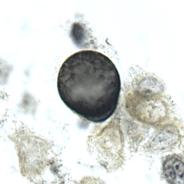Disease caused by an organism in the genus Ichthyobodo (also known formally as Costia) is commonly referred to as Ichthyobodiasis (or Costiasis). This fish pathogen is a 5-10 um flagellated protozoan parasite and is called both Ichthyobodo necator and Ichthyobodo pyriformis in scientific literature. The pathogen is spread from one fish to another, making it a significant disease in fish aquaculture. In addition, I. necator has a very wide host range, including both salmonids and other fish species. Juvenile fish are the most susceptible to the parasite. Common disease signs include listlessness, anorexia and flashing behavior, and in more advanced cases a blue-gray film will appear on the surface of the fish. If the gills are infested, gill hyperplasia and lamellar fusion can be seen, as well as secondary fungal infections. Ichthyobodo infection does not pose any human health concerns.
also known as
costia
Ichthyobodo necatrix
Distribution
Widespread - especially in fish in poor quality water
Hosts
Many fish species
Detection Methods:
microscopic exam - wet mount
Target tissue
Gills and body surfaces
References


